#Astrophotography Astronomy MessierObjects
Explore tagged Tumblr posts
Text
The Triangulum Galaxy
The Triangulum Galaxy is the third largest member of our local cluster of galaxies. At three million light years distance, it is considered nearby on a full cosmic scale.
This neighbouring galaxy is quite different from ours. Note, in the image, several red blemishes. These are large star-forming areas that are different from those in our galaxy.
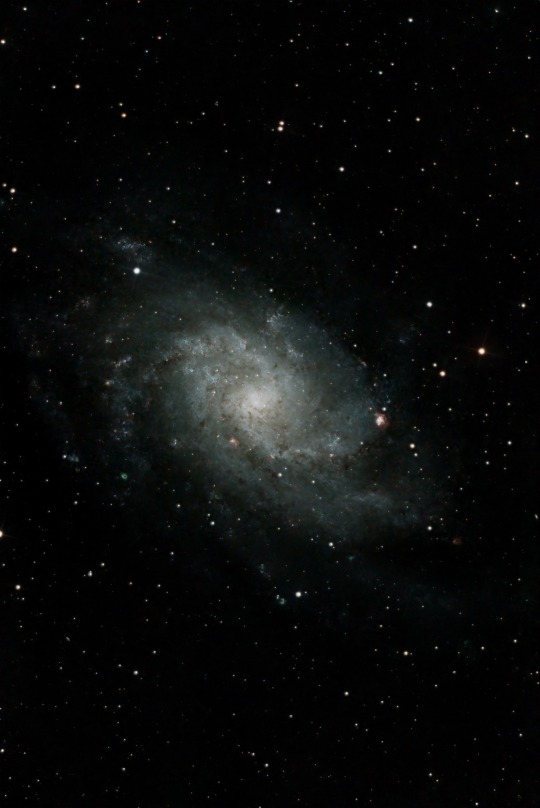
I photographed the Triangulum Galaxy from my garden in Strasbourg France on two nights: October 6, 2024 and December 27, 2024.
This is an ensemble of 75 images, where each is a three minute exposure (over 3.5 hours of total exposure).
#astrophotography#astrophotographie#astronomie#astrophotographiefrance#astronomy#strasbourg#triangulum#triangulum galaxy#messier33#messierobjects#astronomiefrance
20 notes
·
View notes
Photo

This is Messier 45. I captured this with my old GE X2600 Bridge Camera in 2015.
0 notes
Photo

Orion’s Nebula, 2021 Single shot from a series of 50 images (f/11, ASA 6400, 15 s) taken wayyy earlier this morning up at the tree farm. Despite moon and Bortle level 7/6 skies very happy with results. Set up: camera body #sony a6000, #canon 500 mm FL-F lens, #fotodiox lens body mount adapter, and #ioptron tracking mount on #manfrotto tripod. . . . @sonyalpha @manfrottoimaginemore @ioptron_telescopes @canonusa @fotodioxpro @wi_dnr @skyandtelescopemag @bbcskyatnightmag @astronomypicturesdaily @astronomy.magazine @midwestlivingmag @country.magazine @mspmag . . . #astronomy #astrophotography #wisconsin #midwest #orionsnebula #skyatnight #nightsky #messierobjects (at Wisconsin) https://www.instagram.com/p/CVLLwi3rdR1/?utm_medium=tumblr
#sony#canon#fotodiox#ioptron#manfrotto#astronomy#astrophotography#wisconsin#midwest#orionsnebula#skyatnight#nightsky#messierobjects
0 notes
Text
The Andromeda Galaxy
In late summer and early autumn, the Andromeda Galaxy is high in the eastern sky after sunset in the northern hemisphere. This is the best time to capture a photo of the Andromeda Galaxy, the most iconic of astrophotography images.
Catalogued as Messier-31 or M31, it is the nearest galaxy at 2.5 million light years. It appears to have a similar size and structure to our galaxy, but there are significant differences. With this proximity, it appears too large in most backyard telescopes.
It is quite bright at the centre, and easily visible with binoculars. The challenge for astrophotographers is to render the faint edges without over-saturating the intense core. However, I keep the core lightly saturated to remind us that the Andromeda Galaxy has a super-massive black hole at the centre.
There is a tenuous halo of stars with darker dust around the galaxy, and the outer edges seem disrupted. Current thinking is that one or both of the smaller satellite galaxies in the photo (M32 and M110) passed through the Andromeda Galaxy long ago.

This is an ensemble of 180 photos where each was a 3 minute exposure (9 hours of astrophotography). I photographed M31 from my garden in Strasbourg France on 2 nights in September 2024.
More information about the Andromeda Galaxy:
#astrophotography#astronomy#astrophotographie#astrophotographiefrance#astronomie#astronomiefrance#messierobjects#andromedagalaxy#messier31#m31#strasbourg
48 notes
·
View notes
Text
Messier-1: The Crab Nebula.
What a story: this is the remnant of a nearby star that exploded in 1054. We know the exact timing because ancient Chinese astronomers documented everything.
So, what you see here is the explosion in progress, but almost a thousand years later.
Note that the remnants of this star, when it exploded, ejected into long strands. It is not clear to me why the explosion created these strands.

I captured this composite image from my garden in Strasbourg France on a cold night in December 2024, and a frosty night in early January 2025. 65 x 180 seconds each. (3.25 hours)
#astrophotography#astronomy#astrophotographie#astronomie#astrophotographiefrance#strasbourg#crab nebula#messierobjects#messier1#astronomiefrance#supernova remnant
17 notes
·
View notes
Text
The Orion Nebula
The magnificent Orion Nebula: The darling of amateur astrophotographers, the Queen of the Winter Sky. It is the brightest nebula in the night sky and easily viewable with binoculars. It is an easy target for beginners, so how can you resist such a beautiful deep-space subject?
At a distance of only 1,300 light years, consider it nearby on the scale of our Milky Way galaxy. It is the closest region of massive star formation, a stellar nursery.
I photographed the Orion Nebula from my garden in Strasbourg France in early February 2024. 46 photos x 60 seconds each.
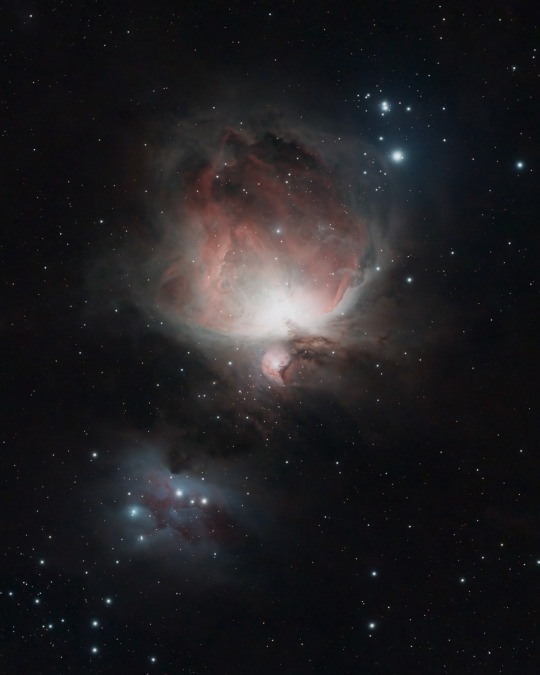
#astrophotography#astrophotographie#astrophotographiefrance#messierobjects#astronomiefrance#astronomy#messier42#orion nebula#astronomie
18 notes
·
View notes
Text
The Pinwheel Galaxy
The Pinwheel Galaxy has a classic open-spiral shape that we view face-on. It is roughly the same size as our galaxy, at a distance of 21 million light-years. As the size of our solar system is about 1 light-day, the scale of the distance to the Pinwheel Galaxy is indeed difficult to grasp.
Our galaxy is likely a closed-spiral shape with proportionally less space between the spiral arms. However, the visible structure of these spiral arms merits close inspection as it may give us a cosmic perspective of what we see in our immediate area.
Look closely at this image and you will notice red-coloured spines on each of the spiral arms. This colour suggests hot-hydrogen in star-forming regions. Sound familiar? Weren’t we looking at these nearby curtains of hot-hydrogen in our own galaxy recently this winter? The Orion Molecular Cloud Complex is only about 1,000 light-years distance and reveals itself to astrophotographers as a vast red curtain of dust and gas. On a galactic scale, is it just a similar red-coloured spine in our own spiral arm that we see from the inside?

This final image is an aggregate of 120 photos, where each was a 3 minute exposure. 70 photos were captured in late March 2025, and combined with 50 photos captured in May 2024. (6 hours of photography). I photographed these images from my garden in Strasbourg France.
#Astronomy#astrophotography#astrophotographie#astronomie#astrophotographiefrance#messier101#pinwheelgalaxy#ngc5457#strasbourg#messierobjects
1 note
·
View note
Text
Bode’s Galaxy and the Cigar Galaxy
Bode’s Galaxy (centre) is catalogued as Messier-81. In the bottom-left is the irregularly-shaped “Cigar Galaxy”, catalogued as Messier-82.

Bode’s Galaxy is about 12 million light years distance, which is close, on a cosmic scale. It is a bright object, and a favourite target for researchers and amateurs. In 2022, “fast radio bursts” were detected. These are rare radio sources that, as yet, cannot be explained.
The Cigar Galaxy is small compared to our Milky Way galaxy, but it is much more luminous. It is classified as a “Starburst Galaxy” because it is an extremely active area of star formation. Adding to the mystery of this strange galaxy was the recent discovery of a unique radio source that might be from a “micro-quasar”, but cannot be fully explained.
At the right of this image is the third member of the “M81 Group”, the small disrupted elliptical galaxy NGC 3077.
I photographed the Messier-81 group of galaxies from my garden in Strasbourg France on two cold evening in January 2024.
70 images x 180 seconds each.
https://en.m.wikipedia.org/wiki/Messier_81
https://en.m.wikipedia.org/wiki/Messier_82
https://en.m.wikipedia.org/wiki/NGC_3077
#astrophotography#astrophotographie#astrophotographiefrance#astronomiefrance#messierobjects#messier81#messier82#astronomy#astronomie
9 notes
·
View notes
Text
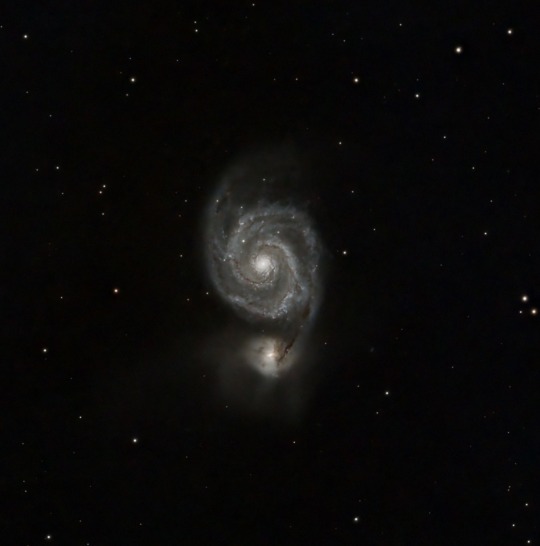
The Whirlpool Galaxy
The Whirlpool Galaxy is actually two galaxies in the process of colliding. It consists of NGC-5194, the main spiral galaxy at the centre, and NGC-5195, the smaller round galaxy colliding with the long spiral arm at 6 o’clock in the picture. At 7 million light years distance, it is nearby on a cosmic scale, but it is not part of our Local Group.
It is interesting to note the distortion of the normally uniform symmetrical shape of a classic open spiral galaxy, likely caused by the unusual gravitational forces experienced during the collision.
The Whirlpool Galaxy is a favourite target for amateurs, because it is big, bright, and interesting. The challenge is to capture the faint cloud of dust and gas at the point of collision.
I photographed the Whirlpool Galaxy from my garden in Strasbourg France in May 2024. This is an aggregate of 48 photos where each was a three minute exposure.
#astrophotography#astronomy#astrophotographiefrance#astrophotographie#messier 51#messier51a#whirlpool galaxy#messierobjects#astronomiefrance#astronomie#ngc5194
6 notes
·
View notes
Text
Messier-17 has several names: the Swan, the Omega, the Horseshoe. It is an intense star-forming region that is nearby, on a galactic scale (5,000 light years distance).
The predominant pink colour suggests hydrogen heated by several intense young stars in the bright centre.
Our eyes are drawn to the swirling dust and gas surrounding the intense core of the nebula.
I photographed Messier-17 from my balcony in Strasbourg France on three nights in July 2023. This is a composite of 57 x 3 minute exposures.
https://en.m.wikipedia.org/wiki/Omega_Nebula

#messier17#astronomy#messierobjects#astrophotographiefrance#astronomiefrance#strasbourg#omeganebula#astrophotographie#astrophotography#messier#astronomie#strasbourg🇫🇷#alsace
4 notes
·
View notes
Text
The Messier-16 Nebula was popularized in the 1990’s by the Hubble Space Telescope. It drew our attention to the columns of dust and gas at the center that it aptly named “The Pillars of Creation”.
The pink colour does suggests that this is a star-forming region, and our understanding of how these columns form does support this.
The legacy of Hubble draws amateurs to photograph this site. After thirty years, we have much better cameras, and vastly more powerful computers at our disposal and can render photos that challenge the Hubble photos from thirty years ago.
Traditionally, there is another name for this structure at the centre: The “Star Queen”. Can you see the whimsical profile of the Queen in her pink robes on the throne?
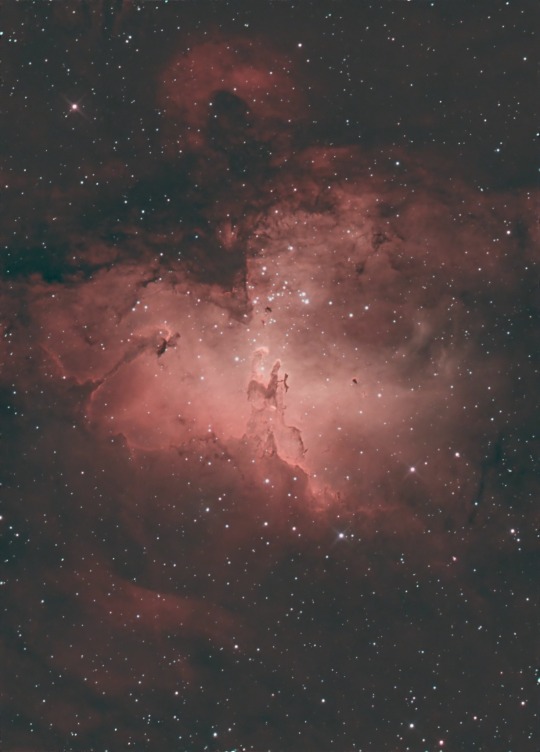
I photographed the Pillars of Creation from my balcony in Strasbourg France over three nights in May 2023. This is an aggregate of 45 images, where each image was a 3 minute exposure.
https://en.m.wikipedia.org/wiki/Eagle_Nebula
https://en.m.wikipedia.org/wiki/Pillars_of_Creation
#astrophotography#astrophotographie#astrophotographiefrance#messierobjects#astronomiefrance#strasbourg#messier16#pillarsofcreation#astronomy#astronomie#messier#nebula
4 notes
·
View notes
Text
Messier-104 is called the “Sombrero Galaxy” because it has a prominent edge like a Mexican hat.
We are viewing it edge-on, and this draws our attention to the contrasting fine dark details revealed at the centre.
The Sombrero Galaxy also has an unusual cloud of dust and gas surrounding it, making it more mysterious than those with the classic pinwheel shape.
This galaxy is 30 million light years distance for earth. In perspective: a radio message to the moon takes about 1 second and to the planets it takes several minutes. However, a radio message to the Sombrero Galaxy takes 30 million years.

This final image is an aggregate of 38 photos where each was a 3 minute exposure. These were considered the best of 68 captured images. I photographed Messier-104 from my balcony in Strasbourg France over two nights in April 2023.
https://en.m.wikipedia.org/wiki/Sombrero_Galaxy
#astrophotography#astrophotographie#astrophotographiefrance#messier104#sombrerogalaxy#messierobjects#astronomy#astronomie#messier#astronomiefrance#strasbourg
2 notes
·
View notes
Photo
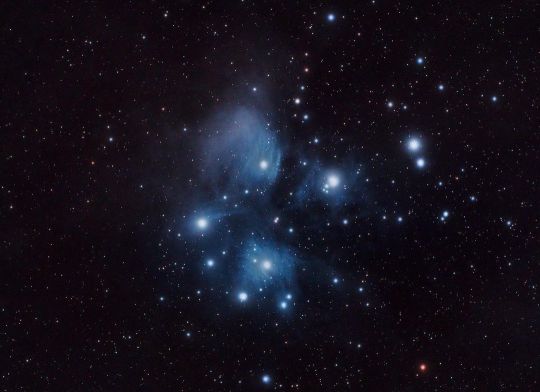
The Pleiades is a nearby cluster of hot blue stars which are illuminating the gas and dust between them.
It is readily visible to our eyes, even in large cities. Look to the east this evening. With an apparent size about half that of a full moon, it is quite impressive.
Countless ancient cultures documented their impressions of it. Europeans call it the “Seven Sisters”, referring to Greek mythology. The Japanese named it “Subaru”.
This is an aggregate of 46 images where each photo was a 5 minute exposure. You need long exposures to reveal the faint reflecting dust clouds.
I photographed the Pleiades Cluster from my terrace in Strasbourg France over three nights in October 2022.
https://en.m.wikipedia.org/wiki/Pleiades
#pleiadescluster #pleiades #messier45 #m45 #messierobjects #astronomy #astrophotography #astrophotographie #astrophotographiefrance #poussièredétoiles
https://www.instagram.com/p/CkTmDw4Miv8/?igshid=NGJjMDIxMWI=
#pleiadescluster#pleiades#messier45#m45#messierobjects#astronomy#astrophotography#astrophotographie#astrophotographiefrance#poussièredétoiles
2 notes
·
View notes
Photo
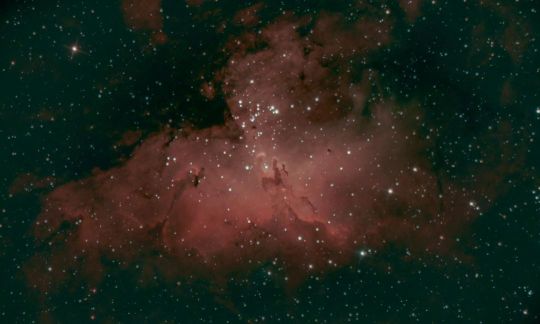
The “Pillars of Creation” were popularized by the Hubble Space Telescope. I also imagine a pink silhouette sitting on a throne, with the whimsical name: “The Star Queen”. This celestial jewel is a nearby star-forming region in our Milky Way galaxy. I photographed the Pillars of Creation from my balcony in Strasbourg France in July 2022. #eaglenebula #messier16 #pillarsofcreation #starqueen #messierobjects #astrophotography #astrophotographiefrance #astronomy #astronomie #astronomiefrance #astronomiealsace (at Strasbourg, France) https://www.instagram.com/p/CgcgE-QM2lu/?igshid=NGJjMDIxMWI=
#eaglenebula#messier16#pillarsofcreation#starqueen#messierobjects#astrophotography#astrophotographiefrance#astronomy#astronomie#astronomiefrance#astronomiealsace
2 notes
·
View notes
Photo

The Swan Nebula is catalogued as Messier-17. It is a hot hydrogen cloud in our galaxy at 5,000 light years distance. I photographed this from my terrace in Bordeaux France, July 2020. #messier17 #messierobjects #ngc6618 #astrophotography #astronomy (at Bordeaux, France) https://www.instagram.com/p/CDWxqX7ngfp/?igshid=7xryn6b22ryp
1 note
·
View note
Photo

An iconic astrophotography subject: the Andromeda Galaxy. At 2.5 million light years, it is the nearest galaxy to us. This is an ensemble of 70 photos: 40 were captured with an L-Enhance filter at Astrofarm France (July 2022) and 30 were captured with an L-Pro filter in Strasbourg (August 2022). The L-Enhance filter emphases, in red, the hydrogen-rich star-forming areas, and the L-Pro filter generally enhances galaxy details, and suppresses the ambient artificial light in cities. This combination did highlight, in red, several spiral arms that are richer in hydrogen than others. #andromeda #andromedagalaxy #messier31 #m31 #messierobjects #messierobject #astrophotography #astrophotographie #astrophotographiefrance #astronomy #astronomie #poussieredetoile #poussieresdetoiles #poussièredétoiles (at Strasbourg, France) https://www.instagram.com/p/Ch9ZdwMM22X/?igshid=NGJjMDIxMWI=
#andromeda#andromedagalaxy#messier31#m31#messierobjects#messierobject#astrophotography#astrophotographie#astrophotographiefrance#astronomy#astronomie#poussieredetoile#poussieresdetoiles#poussièredétoiles
0 notes